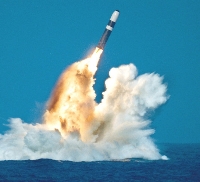The first resounding changes in the USSR were not delayed to arrive, with the perestroijka of Gorbachev.
The Treaty on Intermediate Nuclear Forces (INF)
When the final victory in the Cold War was now obvious, it came in 1987 to the signing, by Ronald Reagan and the Soviet Secretary, of the Treaty called the Intermediate Range Nuclear Forces Treaty, also known as INF, which It bans two classes of nuclear missiles: those ground-based ballistic with range between 1000 and 5500 km, and those of cruise (cruise) with short or intermediate radius, with range between 500 and 1000 km. It led to the undoubted benefit of the complete elimination of almost 2700 missiles, of which 860 Americans and 1800 Soviets, but did not solve not only the most general problem of the permanence of nuclear arsenals anyway able to destroy everything It exists on Earth, but not even the question of the gray area that we were talking about at the beginning, represented by nuclear weapons that are, let’s say, more usable.
As this is true, it has begun to manifest itself for a long time, not only therefore, as it would appear reading the newspapers of these weeks, following the decision taken by current President Donald Trump on 20 October.
Few remember in fact, for example, that the United States of Bush Jr. They withdrew from the treaty banning the ABMs (Anti-Balistic Missiles) on 13 December 2001, thanks to the anti-Islamic Crusade with which in the same days the Afghan campaign had started, whose unsuccessful results are today, seventeen years later, under the eyes of the whole world.
It took advantage of the climate of global mobilization against terrorism to pave the way, already predicted by the Reagan Star Wars, to create a missile missile system that would theoretically make possible even a nuclear confrontation, in Presumption of being able to break down in flight as many missiles with nuclear warheads launched by the enemy.
Not only Trump but also Obama
This was realised during the Obama Presidency with the installation of the GMD (Ground Missile Defense), a network that today would count 44 interceptors arranged throughout the territory of the Usa, with a first defensive line constituted by 44 missiles Interceptors, located between Alaska and California: an apparatus destined to reach 100 stations by 2020.
No less relevant, in 2003, another decision of the Department of Defense (DoD) uses: The one that gave life to a system called Prompt Global Strike (PGS) whose mission is to give the United States the opportunity to strike with conventional weapons targets in Any point on Earth in less than an hour, with no need to use advanced bases. The system will be able to use all the available weapons panoply, from the most classic ones (bombers, ballistic and cruise missiles) to the more advanced ones, like the so-called boost-glide technology that associates a hypersonic thruster, that is, able to reach Even over 20 times the speed of the sound, to a glide where the launch of the chosen headboard is carried out. These weapons, presented as conventional, however, would be perfectly associated with nuclear warheads, thus making it impossible for the opponent to assess whether or not a nuclear attack was unleashed against him.
In 2007, the United States and Russia, well aware of the new lethal armaments race, proposed to the UN to extend the prohibitions established by the IFNT to the entire international community. But some countries, recently endowed with this type of weapons, were not willing to give it up-firstly China. Others, mindful of the previous denials by the nuclear Powers to proceed with further disarms, would not accept this proposal which, on the military level, would obviously have benefited mainly from the Usa and Russia.
In this way the possibility of launching a broader process of eliminating nuclear weapons in the medium range vanished. The gray area remained intact.


